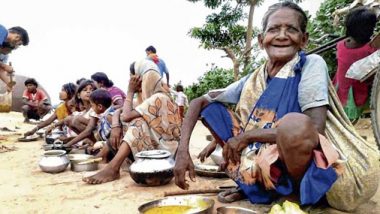New Delhi, October 19: India's Global Hunger Index 2021 ranking at 101st position "unfortunately" reflects the reality of the country where hunger has accentuated since the COVID-19 pandemic outbreak, Oxfam India said. India slipped to 101st position in the Global Hunger Index (GHI) of 116 countries, from its 2020 position of 94th, and is behind its neighbours Pakistan, Bangladesh and Nepal.
Reacting sharply to the report, the Ministry of Women and Child Development had said it was "shocking" to find that the Global Hunger Report 2021 has lowered the rank of India on the basis of FAO estimate on proportion of undernourished population, which is found to be "devoid of ground reality and facts and suffers from serious methodological issues''.
Oxfam India said the GHI data which states that India dropped to the hunger-level ranks by seven spots to the 101st spot "unfortunately reflects the reality of the country where hunger accentuated since the COVID-19 pandemic”.
“This trend of undernutrition in India is unfortunately not new, and is actually based on the government's own National Family Health Survey (NHFS) data. Petrol and Diesel Prices in India on October 19, 2021: Fuel Prices Remain Unchanged; Check Rates in Delhi, Mumbai and Other Metro Cities.
The data shows that between 2015 and 2019, a large number of Indian states actually ended up reversing the gains made on child nutrition parameters.
“This loss of nutrition should be of concern because it has intergenerational effects, to put it simply - the latest data shows that in several parts of India, children born between 2015 and 2019 are more malnourished than the previous generation,” said Amitabh Behar, CEO, Oxfam India.
The Union budget this year discussed India's POSHAN (Prime Minister's Overarching Scheme for Holistic Nourishment) scheme with “increased” allocations to POSHAN 2.0. However, the POSHAN Abhiyaan launched in 2017 to improve nutrition among children, pregnant women and lactating mothers, has languished due to poor funding resulting from clever clubbing with other schemes within the health-budget and even worse implementation.
Only 0.57 per cent of the current budget has been allocated towards funding the actual POSHAN scheme and the amount for child nutrition dropped by a whopping 18.5 per cent compared to 2020-21, Oxfam India said in a statement.
"There are massive negative consequences to not arresting high levels of malnutrition. In India, both our adult population and children are at risk. For instance, the BMI of a quarter of our (teenage and middle aged) women is below the standard global norm, more than half of our women suffer from anaemia.
India's GHI score has also decelerated -- from 38.8 in 2000 to the range of 28.8 - 27.5 between 2012 and 2021. The GHI score is calculated on four indicators --undernourishment; child wasting (the share of children under the age of five who are wasted i.e who have low weight for their height, reflecting acute undernutrition); child stunting (children under the age of five who have low height for their age, reflecting chronic undernutrition) and child mortality (the mortality rate of children under the age of five).












 Quickly
Quickly











